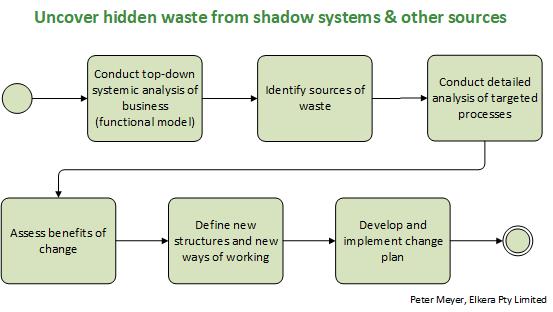Uncovering the hidden waste behind every-day work practices
By Peter Meyer, Principal Consultant, Elkera Pty Limited
1 September 2025
Many medium-sized organisations are wasting money and time every day through hidden waste. Common sources of that waste are shadow systems: spreadsheets and workarounds that employees create when official systems don’t serve their needs.
I recently observed a case in one organisation I worked with. The organisation had two different database systems that recorded similar information to support editorial processes to keep official information up to date. Neither of those systems recorded or reported all the information that was needed. Staff had developed a separate spreadsheet to record information collected from the database systems and additional information that they needed. Thus, overlapping content was recorded in three places. Despite a huge effort collecting and recording data, there was not a single, authoritative source for that data.
Shadow systems and other wasteful work practices commonly occur in organisations that operate with a siloed structure, where business systems and work processes are set up to serve a particular work unit, not necessarily the needs of the whole organisation. Different teams build their own spreadsheets for the same data, without coordination or sharing.
What are the costs of these wasteful work practices?
Depending on the scale of the problem, there can be substantial costs associated with shadow systems and other wasteful work practices:
Duplicated effort – There are direct costs where several employees expend effort to record the same information.
Missed opportunities – Often, the shadow system is poorly designed. It may deliver basic benefits to its creators but the information is inaccessible to others within the organisation who could use it. Collaboration between work units may be inhibited. Employees may guard their own data because they fear that sharing it will introduce compromises or extra effort.
Poor decisions – Almost certainly, there will be discrepancies between the multiple information source, either because of errors in recording or the information is not current. Someone is using inaccurate information.
Risks to the organisation – Information recorded in shadow systems may not be adequately secured against improper disclosure.
What should be done about wasteful work practices?
Not every shadow system is bad. In particular cases, they may be effective solutions to the problems that employees face. However, in many cases, some or all of the problems described earlier are present and impose significant costs on the organisation.
To assess those costs it is necessary to understand the real sources of problems. Shadow systems are symptoms of larger organisational problems. They are not causes.
The root causes of those problems are most likely found in the current organisational structure and systems.
An effective way to understand those problems is to undertake a top-down, systemic analysis to develop a functional model of the business as described in my article: Growing pains for medium businesses: Why you should clearly define internal business structure.
A functional model analysis will provide management with the tools needed to dig down in a more detailed way to fully understand specific problems and to assess their costs.
Initiating change
Change is a challenge both to leaders and to employees.
In many cases, leaders hesitate to initiate change because of the high level of uncertainty that is involved. In my recent article, The leaders who succeed overcome the barriers to organisational change, I describe how leaders can manage the uncertainties and take the first steps to planning changes that will benefit them and their organisations.
Employees also can be reluctant to change. They may have a deep-rooted preference for familiar routines and have difficulty envisaging different ways of working.
In my recent article: Set up your organisational change project for success before the work begins, I discuss the critical elements in achieving employee openness to change.
Conclusions
Shadow systems are often hidden from management’s gaze, but they represent real waste and risk.
With a systemic, top-down analysis leaders can identify the sources of duplication and waste. They can then identify how to remove those costs through improved structures, processes and systems that should deliver real, measurable benefits.
If the scenarios described in this article occur in your organisation, I invite you to contact me to discuss how to remove those hidden costs and achieve real gains in efficiency, accuracy, and collaboration.


